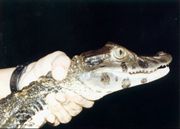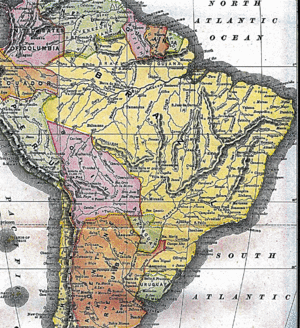Acre (state)
| State of Acre | |||
|---|---|---|---|
| — State — | |||
|
|||
 |
|||
| Country | |||
| Capital | Rio Branco | ||
| Government | |||
| - Governor | Binho Marques Workers' Party | ||
| - Vice Governor | Carlos César Messias | ||
| Area | |||
| - Total | 152,581 km2 (58,911.9 sq mi) | ||
| Area rank | 16th | ||
| Population (2005 census) | |||
| - Total | 646,962 | ||
| - Estimate (2006) | 686,652 | ||
| - Rank | 25th | ||
| - Density | 4.2/km2 (11/sq mi) | ||
| - Density rank | 23rd | ||
| Demonym | Acreano | ||
| GDP | |||
| - Year | 2006 estimate | ||
| - Total | R$ 4,835,000,000 (26th) | ||
| - Per capita | R$ 7,041 (18th) | ||
| HDI | |||
| - Year | 2005 | ||
| - Category | 0.751 – medium (16th) | ||
| Time zone | BRT-1 (UTC-4) | ||
| Postal Code | 69900-000 to 69999-000 | ||
| ISO 3166 code | BR-AC | ||
Acre (Brazilian Portuguese: [ˈakɾi]) is a state of Brazil, located in the Northern Region. The state borders Amazonas to the north, Rondônia to the east, Bolivia to the south and the Ucayali Region of Peru to the west.
Contents |
Geography
Acre is covered mostly by the jungle of the Amazon Rainforest. The state is a well-known producer and exporter of rubber. The Acre River runs along the southern boundary of the state, forming the border with Bolivia.
Climate
An equatorial climate is a type of tropical climate in which there is no dry season – all months have mean precipitation values of at least 60 mm. It is usually found at latitudes within five degrees of the equator – which are dominated by the Intertropical Convergence Zone. The equatorial climate is denoted Af in the Köppen climate classification. Tropical rainforest is the natural vegetation in equatorial regions.

Vegetation
The Amazon represents over half of the planet's remaining rainforests and comprises the largest and most species-rich tract of tropical rainforest in the world. Wet tropical forests are the most species-rich biome, and tropical forests in the Americas are consistently more species-rich than the wet forests in Africa and Asia.[1] As the largest tract of tropical rainforest in the Americas, the Amazonian rainforests have unparalleled biodiversity. More than 1/3 of all species in the world live in the Amazon Rainforest.[2]
History


.jpg)
.jpg)
The territory was assigned to Bolivia in 1867 by the Treaty of Ayacucho with Brazil. From about 1860, Acre had been overrun by Brazilians, who made up 99% of the population. In 1899-1900, the Spanish journalist and former diplomat Luis Galvez Rodrigues de Aria led an expedition that sought to seize control of what is now Acre from Bolivia. The expedition was secretly financed by the Amazonas state government and aimed to incorporate Acre into Brazil after its independence from Bolivia. Galvez declared himself president of the first Republic of Acre on July 14, 1899. That first republic lasted until March 1900, when the Brazilian government sent troops to arrest Galvez and give Acre back to Bolivia. Galvez was deported to Spain and the inhabitants of Acre found themselves up against both Bolivia and Brazil. In spite of a second attempt at creating an Acre Republic (November 1900 - December 24, 1900), Acre remained part of Bolivia until 1903.
After the failure of the second attempt of Acre to secede from Bolivia, a veteran soldier from Rio Grande do Sul who had fought in the Federalist Revolution of 1893, José Plácido de Castro, was approached by the Acrean Revolution leaders and offered the opportunity to lead the independence movement against the Bolivians. Plácido, who had been working in Acre since 1899 as a chief surveyor of a surveying expedition and was about to go back to Rio de Janeiro, accepted the offer. He imposed strict military discipline and reorganized the revolutionary army, which reached 30,000 men.
The Acrean army won battle after battle and on January 27, 1903, José Plácido de Castro declared the Third Republic of Acre. President Rodrigues Alves of Brazil, ordered Brazilian troops into Northern Acre in order to replace Plácido as the president of Acre. Through Barão do Rio Branco's most able ministerial diplomacy, the question was settled. After negotiations a treaty was signed. The Treaty of Petrópolis, which was signed on November 11, 1903, gave Brazil Acre (191.000 km²) in exchange for lands in Mato Grosso, payment of two million pounds sterling and an undertaking to construct the Madeira-Mamoré railroad that would allow Bolivia access to the outside world. On February 25, 1904 it was officially made a federal territory of Brazil, and a federal state in 1962.
Acre was the home of the rubber tapper Chico Mendes, who was murdered at the orders of powerful cattle ranchers in 1988.
Demographics
According to the IBGE of 2007, there were 664,000 people residing in the state. The population density was 4.5 inh./km².
Urbanization: 69.6% (2006); Population growth: 3.3% (1991–2000); Houses: 162,000 (2006).[3]
The last PNAD (National Research for Sample of Domiciles) census revealed the following numbers: 441,000 Brown (Multiracial) people (66.5%), 172,000 White (26.0%), 45,000 Black (6.8%), 4,000 Asian or Amerindian people (0.7%).[4]
Economy
.jpg)
The service sector is the largest component of GDP at 66%, followed by the industrial sector at 28.1%. Agriculture represents 5.9%, of GDP (2004). Acre exports: wood 85.6%, poultry (chicken and wild turkey) 4.7%, wood products 1.7% (2002).
Share of the Brazilian economy: 0.2% (2005).
Education
Portuguese is the official national language, and thus the primary language taught in schools. But English and Spanish are part of the official high school curriculum.
Educational institutions
- Universidade Federal do Acre (Ufac) (Federal University of Acre);
- Faculdade da Amazônia Ocidental (Faao) (College of Western Amazon);
- Faculdade de Ciências Jurídicas e Sociais Aplicadas Rio Branco (Firb);
- Instituto de Educação, Ciência e Tecnologia do Vale do Juruá (Ieval);
- Instituto de Ensino Superior do Acre (Iesacre);
- União Educacional do Norte (Uninorte).
Infrastructure
International Airport

Rio Branco International Airport is located in a rural zone of the municipality of Rio Branco, in the state of Acre. It was opened on November 2, 1999 with a unique characteristic: it moved 22 kilometers away from the previous airport site. Rio Branco Airport serves domestic and international flights (by scheduled carriers and air taxi firms) along with general and military aviation. The terminal can receive 270 thousand passengers a year and serves an average of 14 daily operations.
- Cruzeiro do Sul
Cruzeiro do Sul International Airport is located 18 kilometers away from the city center, which helps access to the Alto Juruá region. It was opened on October 28, 1970 and absorbed by Infraero on March 31, 1980. The airport infrastructure was built in 1976 by the municipal government. In 1994 the runway was totally renovated.
Highways
- BR-364 (Rio Branco to Rondônia);
- BR-317 (Rio Braco to south of Acre);
- AC-040 (Rio Branco to Plácido de Castro);
- AC-401 (Plácido de Castro to Acrelândia);
- AC-010 (Rio Branco to Porto Acre).
Sports

Rio Branco provides visitors and residents with various sport activities.
- Stadiums
- Arena da Floresta stadium;
- José de Melo stadium;
- Federação Acreana de Futebol stadium;
- Dom Giocondo Maria Grotti stadium;
- Adauto de Brito stadium;
- and many others.
The Arena da Floresta stadium in Rio Branco was one of the 18 candidates to host games in the 2014 FIFA World Cup, which will be held in Brazil, but did not make the final 12 chosen.
Indigenous population
Acre is inhabited by various indigenous groups of the Panoan language family, including Kashinawa, Jaminawa and Xanenawa. There are also three groups of other language families, Madiha (Kulina) of the Arawan family as well as Yine (Manchineri) and Ashaninka (Kampa) of the Arawakan family. Those groups have terrible life's conditions and do not receive enough attention of population and government.
Flag
The flag was adopted on March 15, 1921. It is a variation of the flags used by the secessionist state of Acre, with the yellow and green parts exchanged and mirrored. The yellow color symbolizes peace, green hope, and the star symbolizes the light which guided those who worked to make Acre a state of Brazil.
Statistical and legal subdivisions
Acre is divided into twenty-two municipalities, five microregions and two mesoregions:
- Vale do Acre
- Microregion of Brasileia
- Assis Brasil
- Brasiléia
- Epitaciolândia
- Xapuri
- Microregion of Rio Branco
- Acrelândia
- Bujari
- Capixaba
- Plácido de Castro
- Porto Acre
- Rio Branco
- Senador Guiomard
- Microregion of Sena Madureira
- Manoel Urbano
- Santa Rosa do Purus
- Sena Madureira
- Microregion of Brasileia
- Vale do Jurua
- Microregion of Cruzeiro do Sul
- Cruzeiro do Sul
- Mâncio Lima
- Marechal Thaumaturgo
- Porto Walter
- Rodrigues Alves
- Microregion of Tarauacá
- Feijó
- Jordão
- Tarauacá
- Microregion of Cruzeiro do Sul
References
- ↑ Turner, I.M. 2001. The ecology of trees in the tropical rain forest. Cambridge University Press, Cambridge. ISBN 0-521-80183-4
- ↑ Amazon Rainforest, Amazon Plants, Amazon River Animals
- ↑ Source: PNAD.
- ↑ (in Portuguese) (PDF) Síntese de Indicadores Sociais 2007. Acre, Brazil: IBGE. 2007. ISBN 85-240-3919-1. ftp://ftp.ibge.gov.br/Indicadores_Sociais/Sintese_de_Indicadores_Sociais_2007/Tabelas. Retrieved 2007-07-18.
See also
- (English) Brazil
- (Portuguese) Official Website
- (English) Brazilian Tourism Portal
- (Portuguese) Acre's location on a 3D globe (Java)
|
||||||||||||||||||||||||||||||||||||||
|
||||||||||||||||||||||||||||||||
|
||||||||||||||||||||

